March began here in the Delectable Mountains with the change from seemingly endless snow to sudden thaw to glassy, lumpy ice. I finally put micro spikes on my muck boots and have only taken them off once or twice since then. Even the goats had trouble staying upright. We put them out into the loafing yard to fork and shovel out the barn on Saturday, and even with the barrowfuls of old hay we’d laid down for traction, it was a bit of an ice rink.
I had intended at least one missive in February, but winter is always like this: January is dark, slow, takes years to pass. February speeds by—not just because it’s a short month, but because work picks back up again, people have emerged from their post-holiday haze, and the capacity for joy is simply diminished in the frigid center of winter (even more so when you’re being terrorized psychologically by the federal government).
I was expecting March in Vermont to be much like February, as I know it won’t properly feel like spring—blossoms on the trees, bare arms—up here until sometime in May. Instead, mud season kicked in, freeze and thaw cycles began, and the sap started running. I’m picking up a maple bourbon pecan pie at a nearby sugar house on Thursday, and they will be serving creemees, and this fact is single-handedly dragging me through an otherwise extra-stressful time of deadlines, meetings, goat work, and mysterious car trouble.
That plus the fact that my time here at Villa Villekulla Farm will soon come to an end. I head back south in two and a half weeks, and I’m trying to prepare mentally and emotionally for my return to real life—cats instead of goats, city instead of country, more free time but less direction in how I spend my days.
I’m also trying to figure out what habits I’ve developed here that I want to retain. Not 5 a.m. wakeups, but maybe earlier rising and bedtimes will stick. Dragging myself outdoors for physical activity in the mornings, rather than remaining inside and sedentary for as long as possible. Maybe I’ll start weightlifting? I have to haul five-gallon buckets of water to and fro three times each day, and I want to capitalize on these gains by regularly lifting heavier things than two-pound weights during virtual barre class. What else? Pulling a card each morning, meditating before I start (computer) work, doing crafts regularly (after messing up the heel turn on the second of two socks, I am in sight of finishing them before it’s too warm for wool).
Things I won’t miss? Being quite so isolated, being away from the people and places and sandwiches I love. Missing my cats, who I’m desperate to snuggle. Feeling like I’ve taken a little life detour—exploring, but not sure how much progress I’ll have made when I get back on the main road. (Honestly, I recommend taking a break from your everyday life in some way or form long enough for it to become routine if you can swing it, but I’m feeling ready for home.)
If you’ve made it this far, you deserve your reward: goat pics. After all, it’s why you opened this email. We’ll get back to topics like farm policy and cheese politics in the near future (I’m sure to learn a lot at the Science & Craft of Raw Milk Cheese Conference, happening this weekend). But that can wait.
Here are just a few of the 40-odd goats I’ve been hanging out with up here:
The Kids
These little critters are my first stop at 6 a.m. each morning. I’m in their shed three times a day, stuffing feeders with hay and scrubbing poopy water buckets and getting filthy hoof prints all over my barn clothes, because they try to climb literally every object. They’re fun and frisky but not technically kids any more—they were born last spring—and the one striking a pose in the middle, Rodney, is pretty hefty at this point. They love hay and minerals and pets and chewing things and running around in a frenzy in response to basically any stimuli.
Puku
Each herd of goats has a strict hierarchy, with the queen at the top and the rest of the goats sorting themselves out below. Puku is the queen of this herd not only because of her personality, which has described by people who love her as both “psychotic” and “demonic,” but also because she’s the only goat with a horn, and it grew in at the perfect angle to fuck everyone else up. (She also sometimes uses it to scratch her own butthole.) When she charges forward to get the first bite of hay or lick of mineral mix, other goats race to get out of the way, swirling through the barn before her in a mini-stampede.
To be a human working among goats, you have to convince them that you’re not just another goat—that you’re an empress, above even the queen (I learned this from a free behavioral basics webinar created by Lee Hennessy of Moxie Ridge Farm). That means walking through, not around, the animals whenever possible, and basically not taking shit from them. For the first month or so I was here, though, Puku treated me like any other goat, which meant that I was getting stabbed on the regular.
After several uncomfortable bruises, and responding to her attempts on my life with a hip check (which is more like how another goat would respond), I was advised to hold my ground, yell, and give Puku a firm bop on the snout when she came for me—which to be clear, was in response to such affronts as “providing clean water” and “entering the barn.”
At first, I felt bad that I was training an animal to flinch from me through physical contact. By now, though, she has begrudgingly decided I’m not worth the trouble and humiliation of being stepped to by such an inferior creature. Sometimes, she even moves out of my way when I’m coming through with full, heavy buckets, and has refrained from inflicting any more contusions (though she has tried). I had to learn to speak her language (despotic rage) for us to coexist.
Frida
The only goat who dares to hold her own against Puku is an underdog in so many ways. Frida has a congenital hoof issue, and by the time she and Lauren, the farmer here, crossed paths, it was too late to be corrected. Plus, when she was born, she wasn’t attended to in time. In the wintry weather in which many farms plan kidding season, that can mean frostbitten ears, and hers had to be removed. But she endured, and now she thrives as the Weird Barbie of the main barn. She has also developed a particular way of communicating with humans, as we give her pain medication in a little cup of grain each morning (she is not part of the milking herd). She makes this alluring face when she sees you coming with her treat.
Mouse
Whenever I’m doing stuff in the barn, the ironically named Mouse, who just might be the biggest goat in the main barn, comes over for nuzzles and pets if I stand still for more than a few seconds. When I am feeding Frida her meds—a process that typically takes a few minutes and requires vigilance to keep other goats from snarfing up her pills—Mouse will come over and snuggle her face on my butt the entire time. Positive reinforcement against Puku’s bad vibes.
Cuddles the Dumpling Goat
With slightly stumpy legs and exceptionally rotund middle, Cuddles is up there for most adorable goat in the main barn. And although the handful of goats due to kid in May have started ballooning a bit, she is not pregnant—in fact, Cuds doesn’t get bred because her udder had to be removed due to a big ol’ tumor. As a fellow zaftig queen who recently had gigantic reproductive tumors removed, I feel a certain kinship with her.
Dudley
The preceding goats are in the main area of the barn with the more mature ladies, but Mr. Duds is in the two-year-old cohort. Due to some health issues when he was tiny, Lauren kept him indoors for a while, and he’s so human-oriented that he’s basically a giant friendly dog with hooves. He always wants pets and nuzzles when you approach.
Dudley is a wether, or castrated male. On a typical dairy farm, he would have been sold for meat or otherwise culled. Here, he gets to be a sweet goofy boy and cuddle with his sisters Pearl and Penelope.
Little Frankie
Frankie is almost three, but she’s the smallest (and fluffiest) of her cohort. Because of her gentle demeanor and wee size, she often missed out on her cohort’s twice-daily grain treat. With limited space at the feeders, she was shut out of this important snack by the larger goats.
For a while, we tried giving Frankie her own little cup of grain, which she’d nose into but never actually eat. She wanted to be at the big kids' table with everyone else! The problem was solved with the addition of a third feeder, and now she confidently stakes out a spot and holds her own against the bigger, more aggressive grain hogs. Yay for Frankie!
The Grannies
Shirley and Sylvia are two of the grannies (the third is Placer, to their left), and they are clearly communing over some gossip or shit-talking the youngsters in this sweet moment. They’re in their mid-teens and were some of Lauren’s original goats. These revered elders get a daily treat of grain and forage pellets, seeds, and a cereal-like mix called Sweet Goat to meet their unique nutritional needs, and little jackets when it’s extra chilly.
The Bucks
I have little interaction with the bucks, Elmore and Vaughan, because Lauren usually handles their care. Rutting season is over now, but for the first few months of the year, they were doing their various horny signals whenever you passed by. Vaughan is a Nubian, so he gets a jacket for warmth in the winter.
Shaggy Elmore is an Alpine, so he handles the cold just fine. Major Black Philip vibes from that one.
Want to help support these goats, many of which are retired from working life and require specialized care? You can donate here.





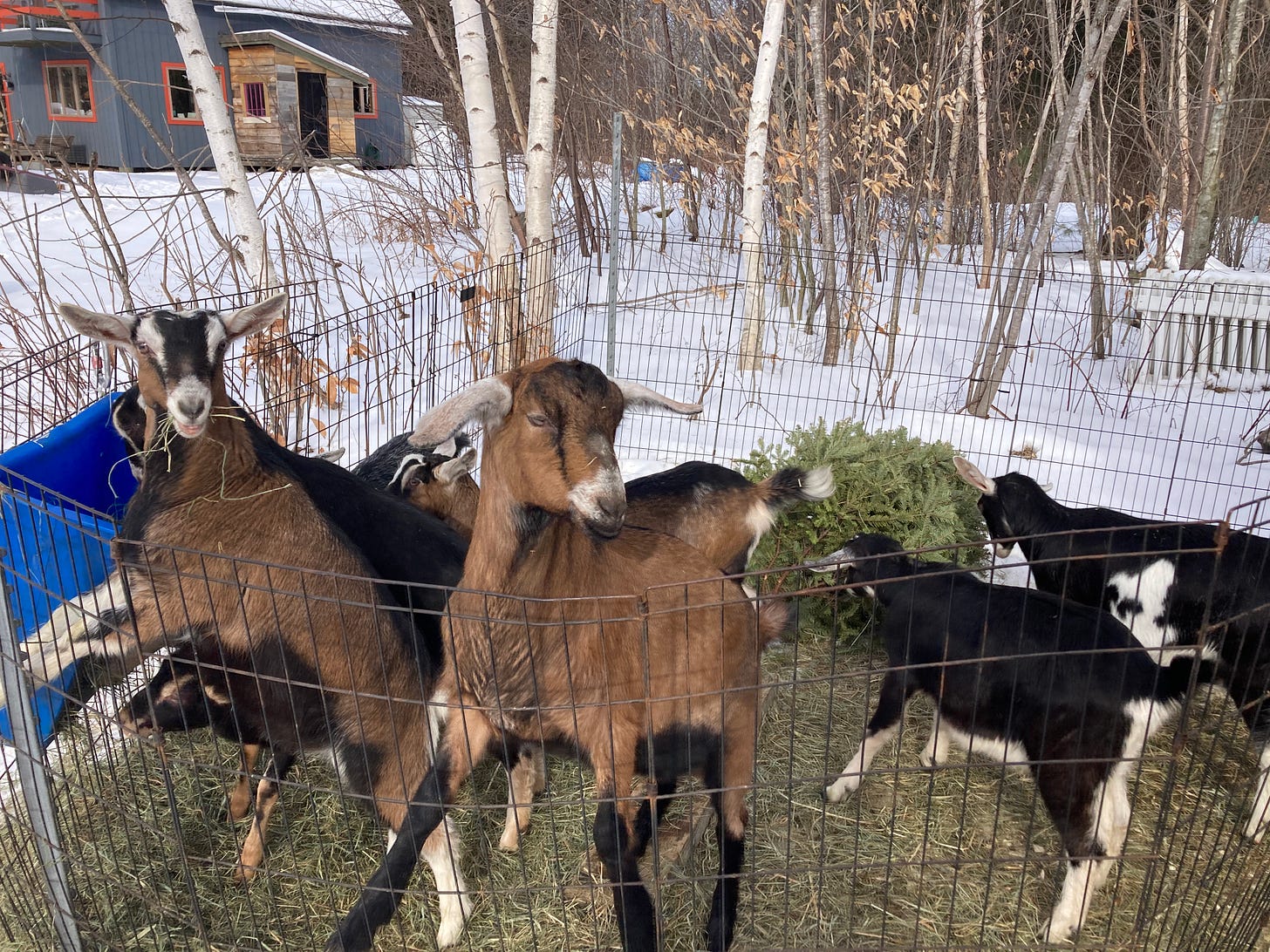
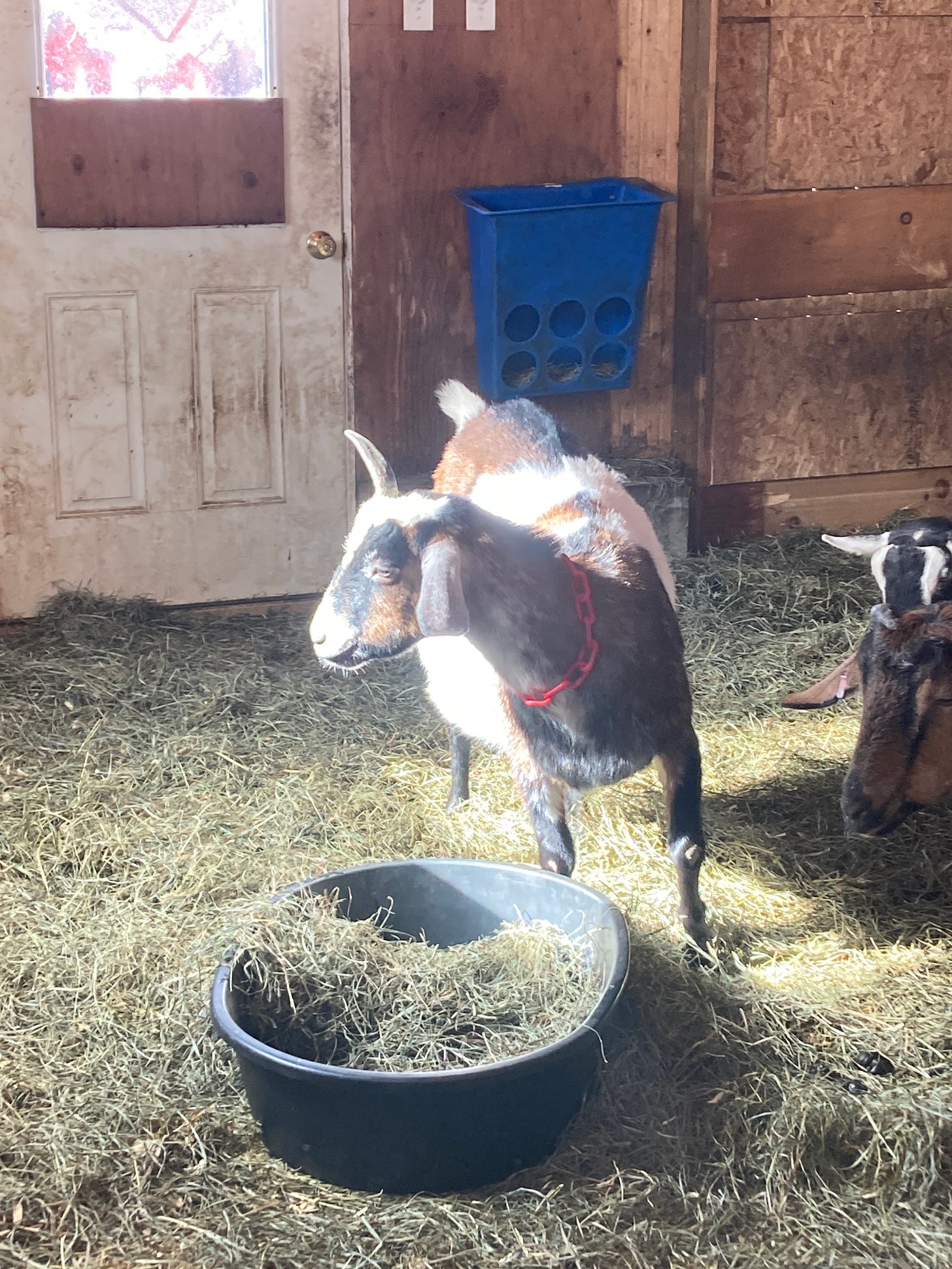
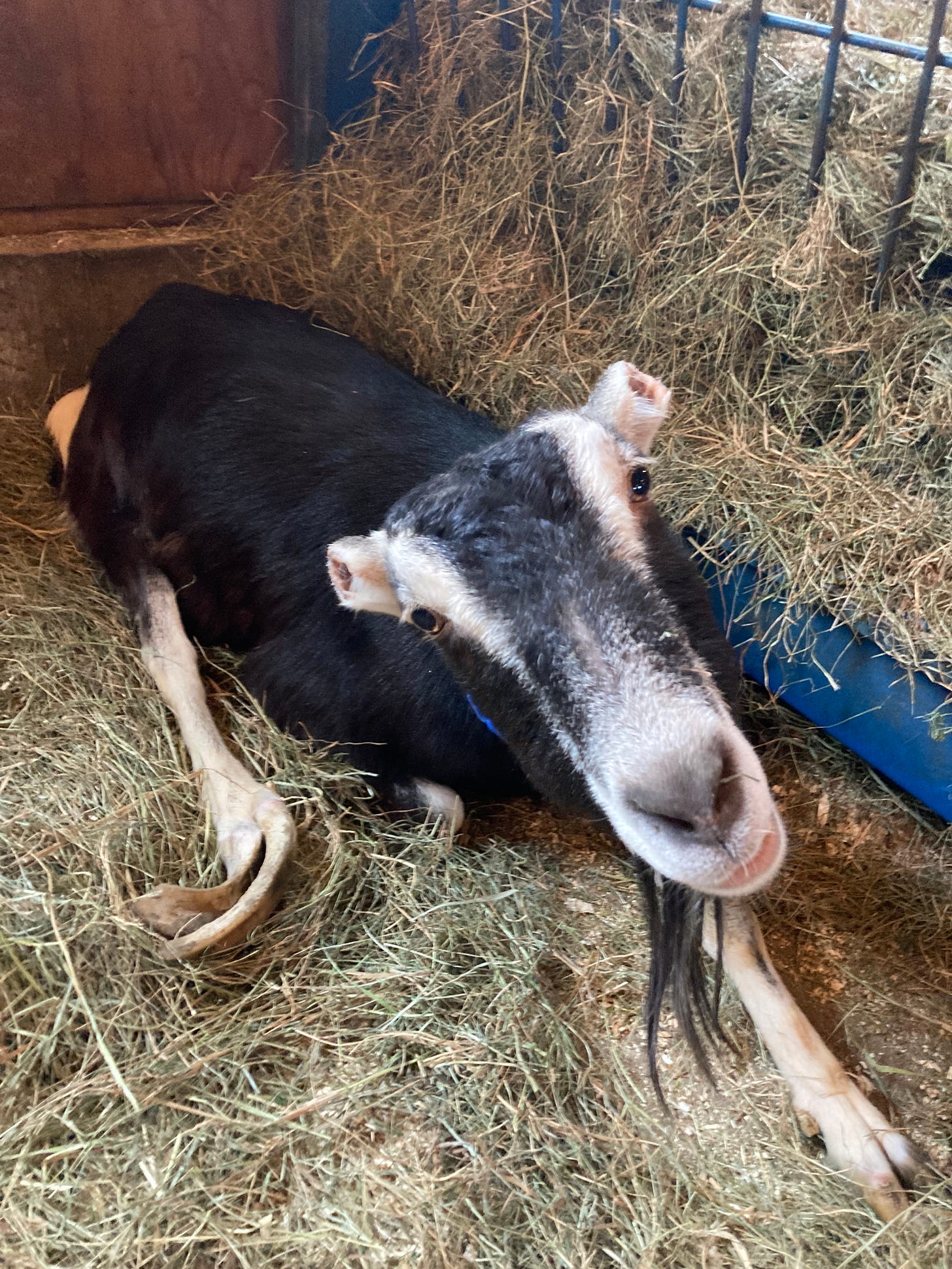
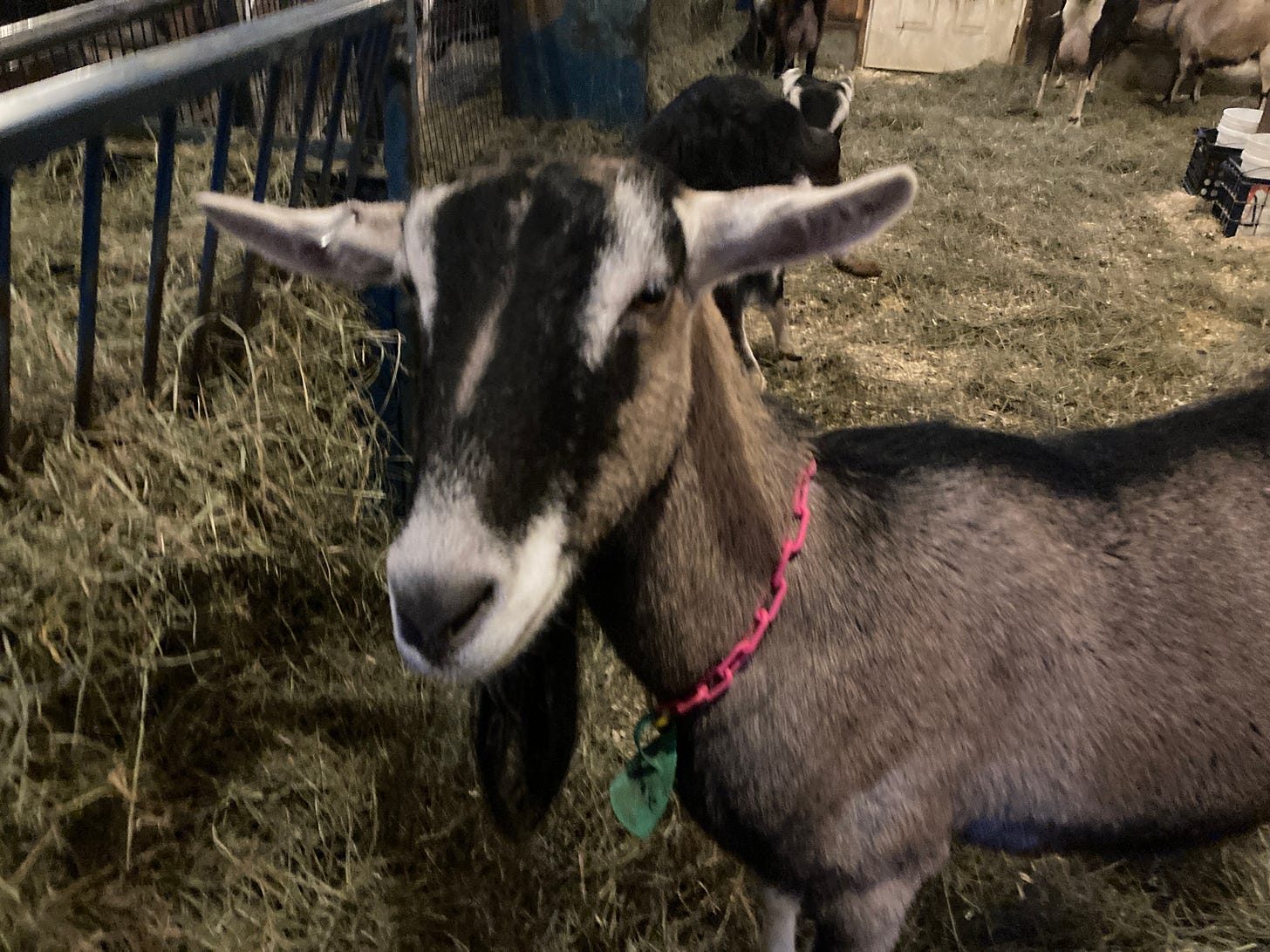
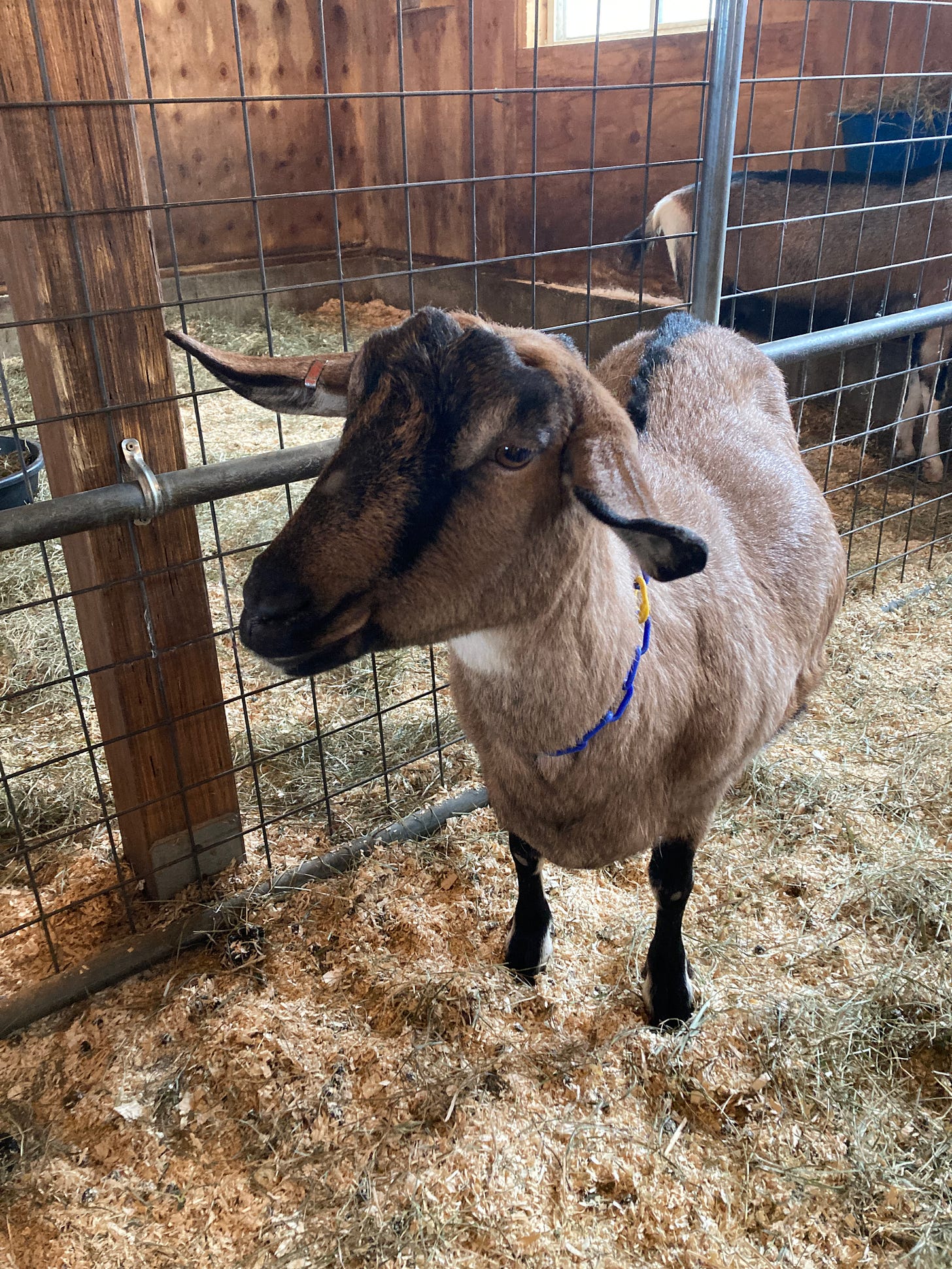
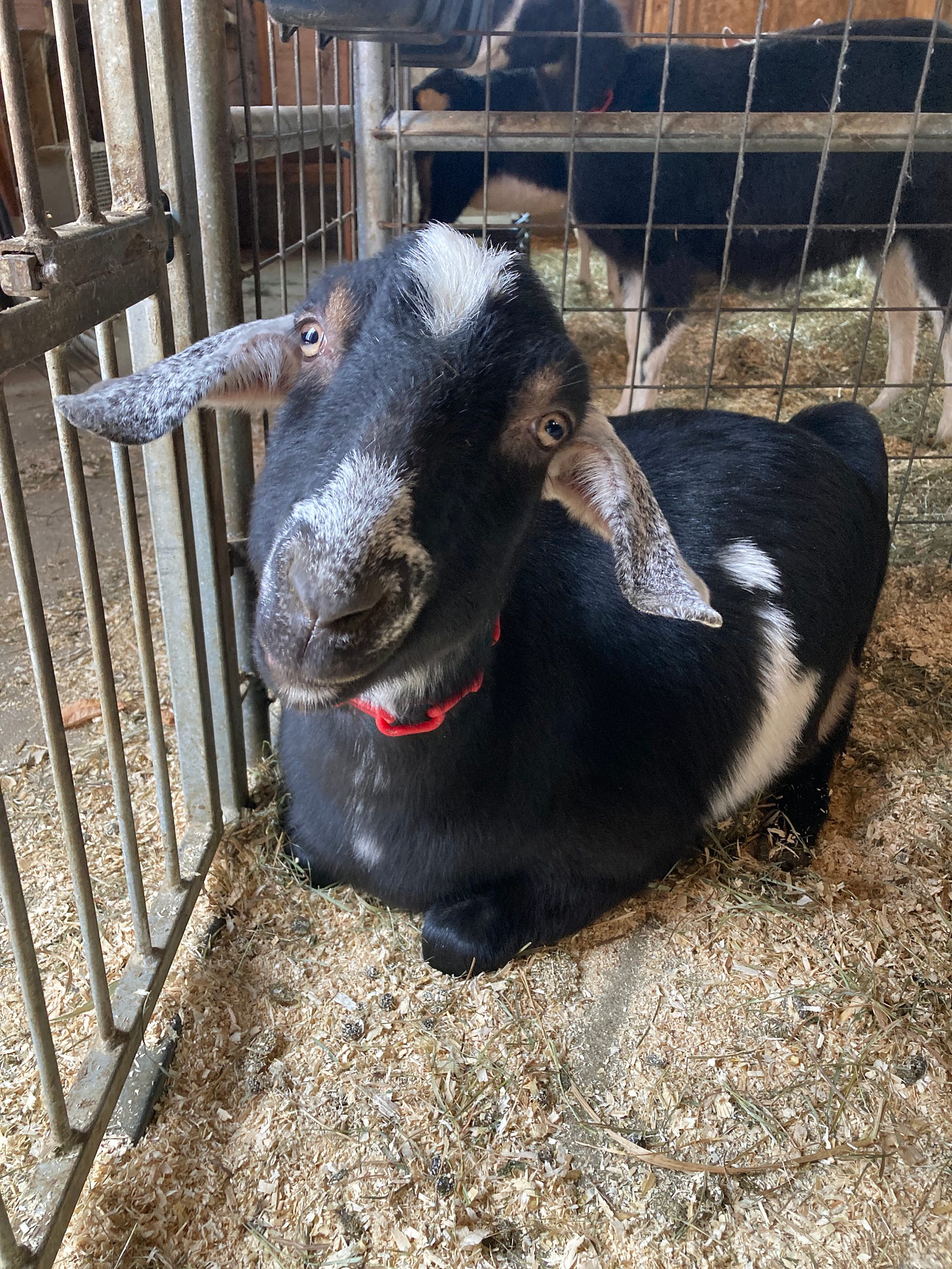
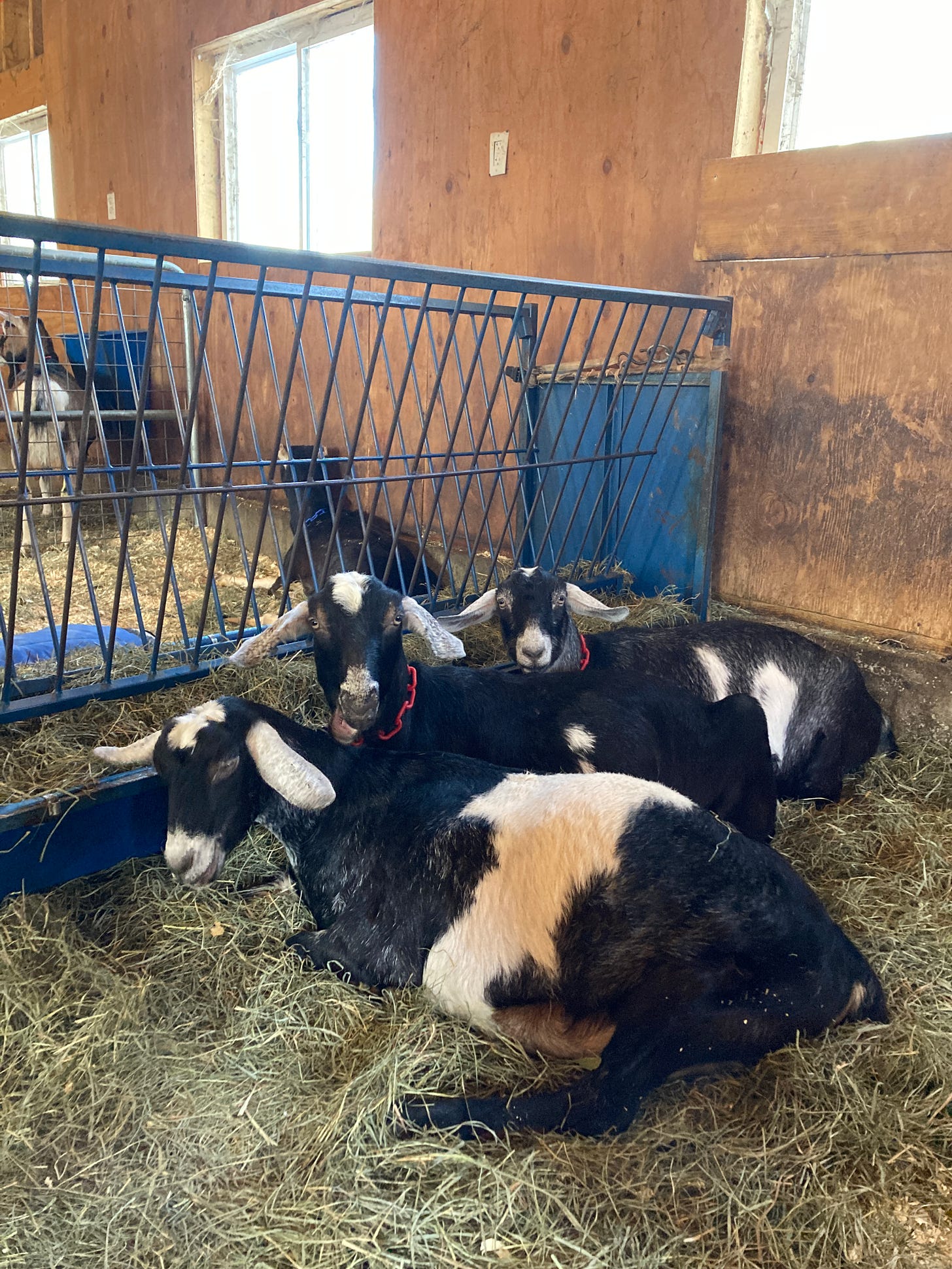
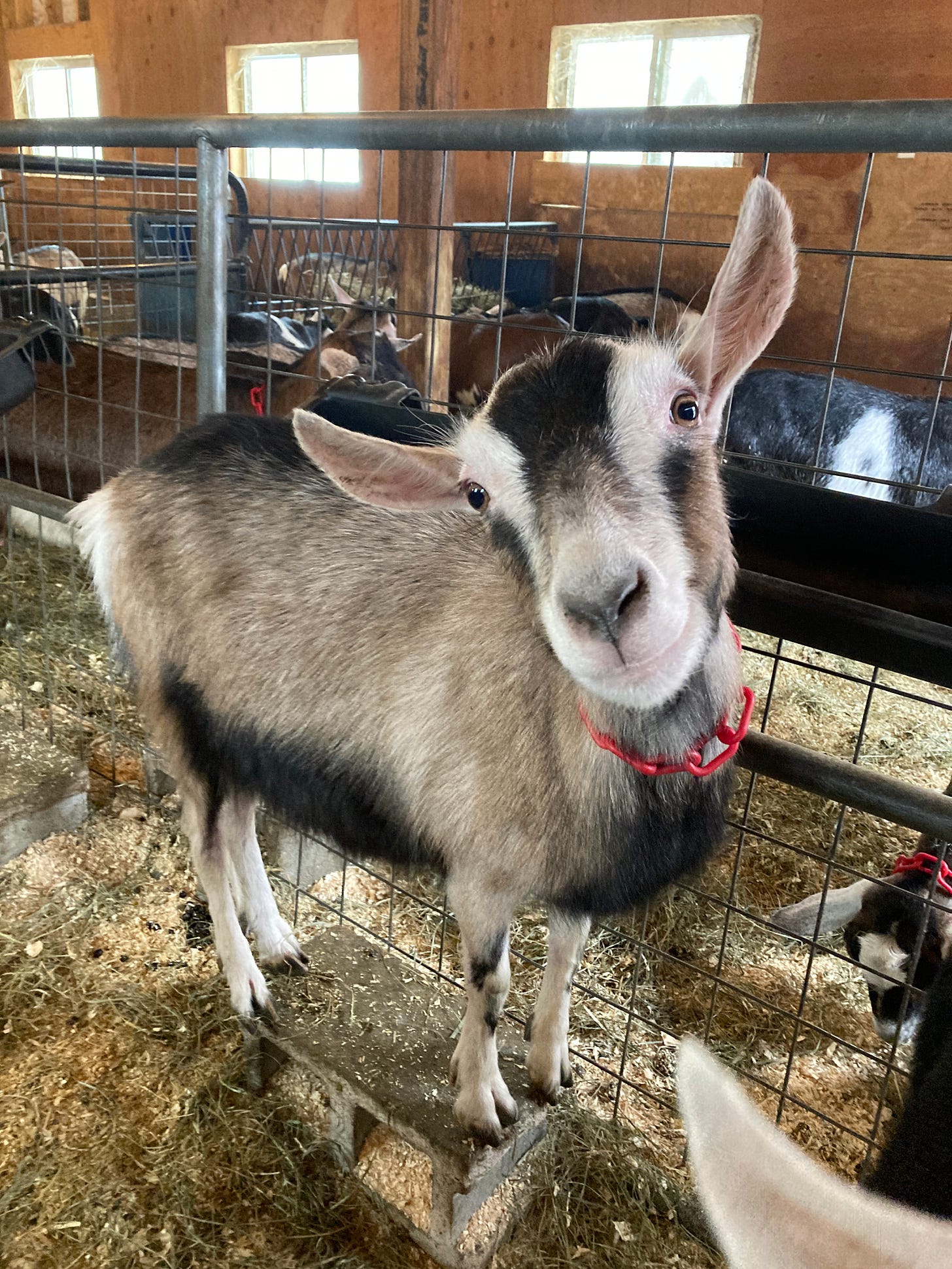
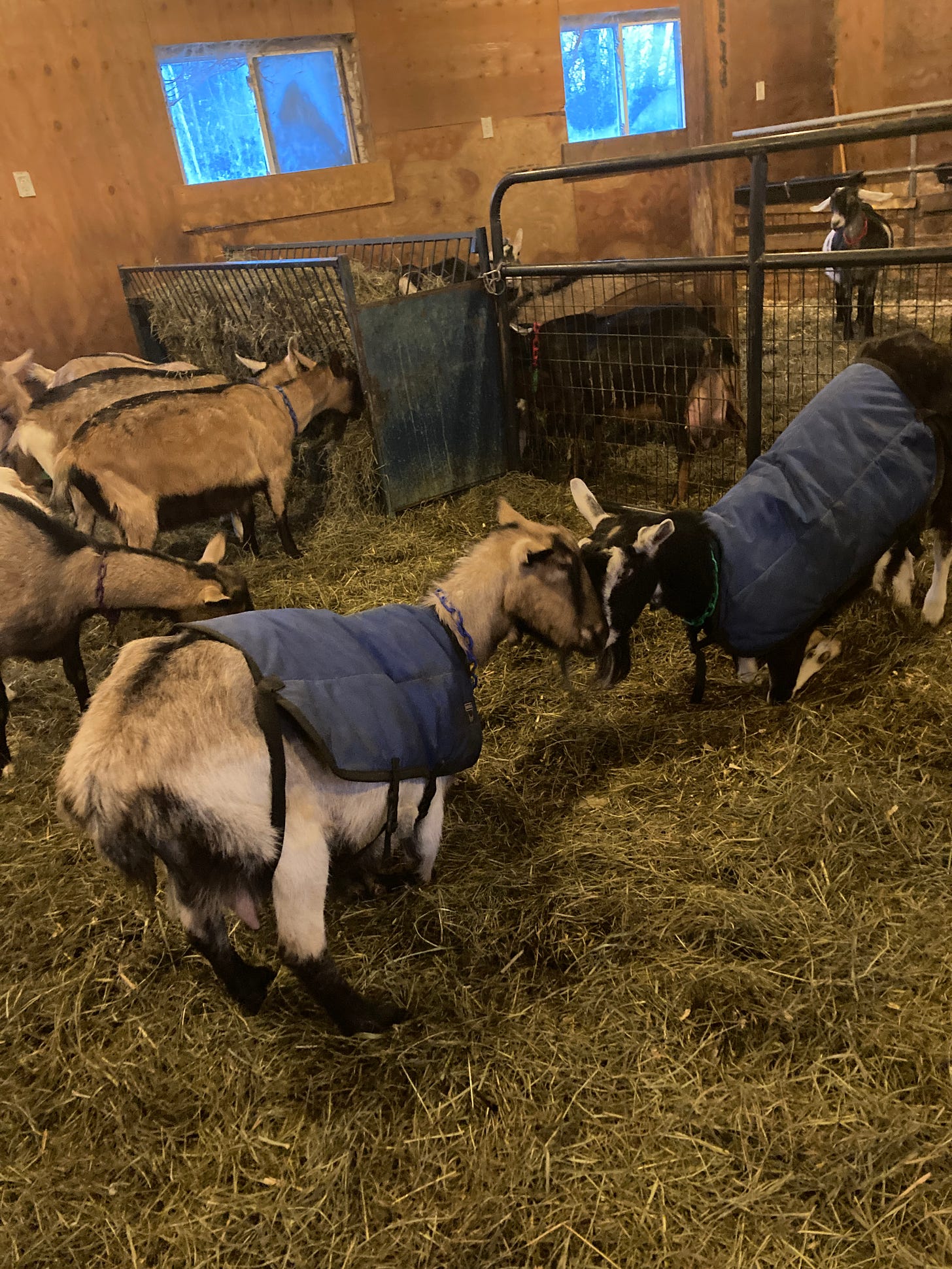
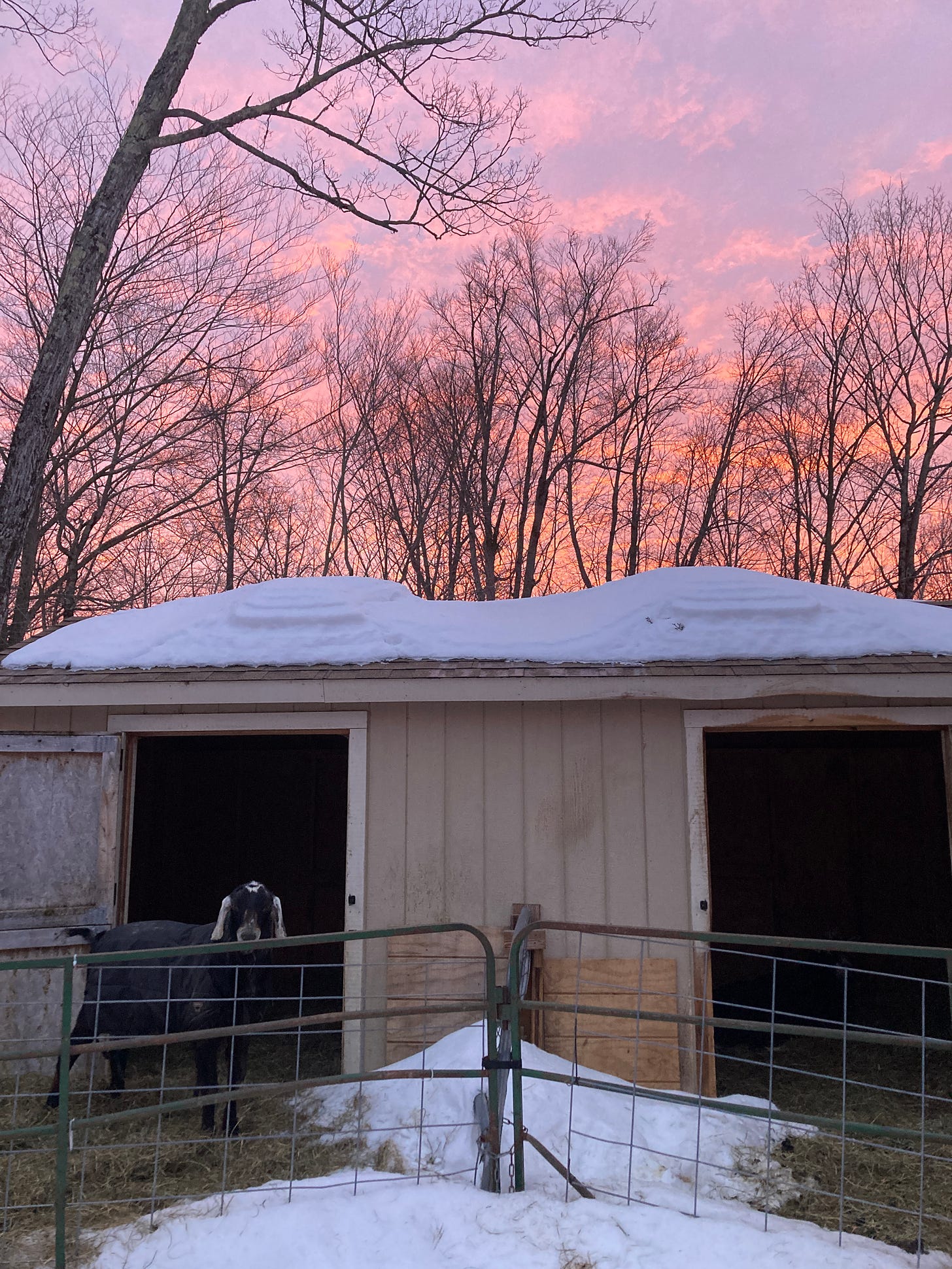
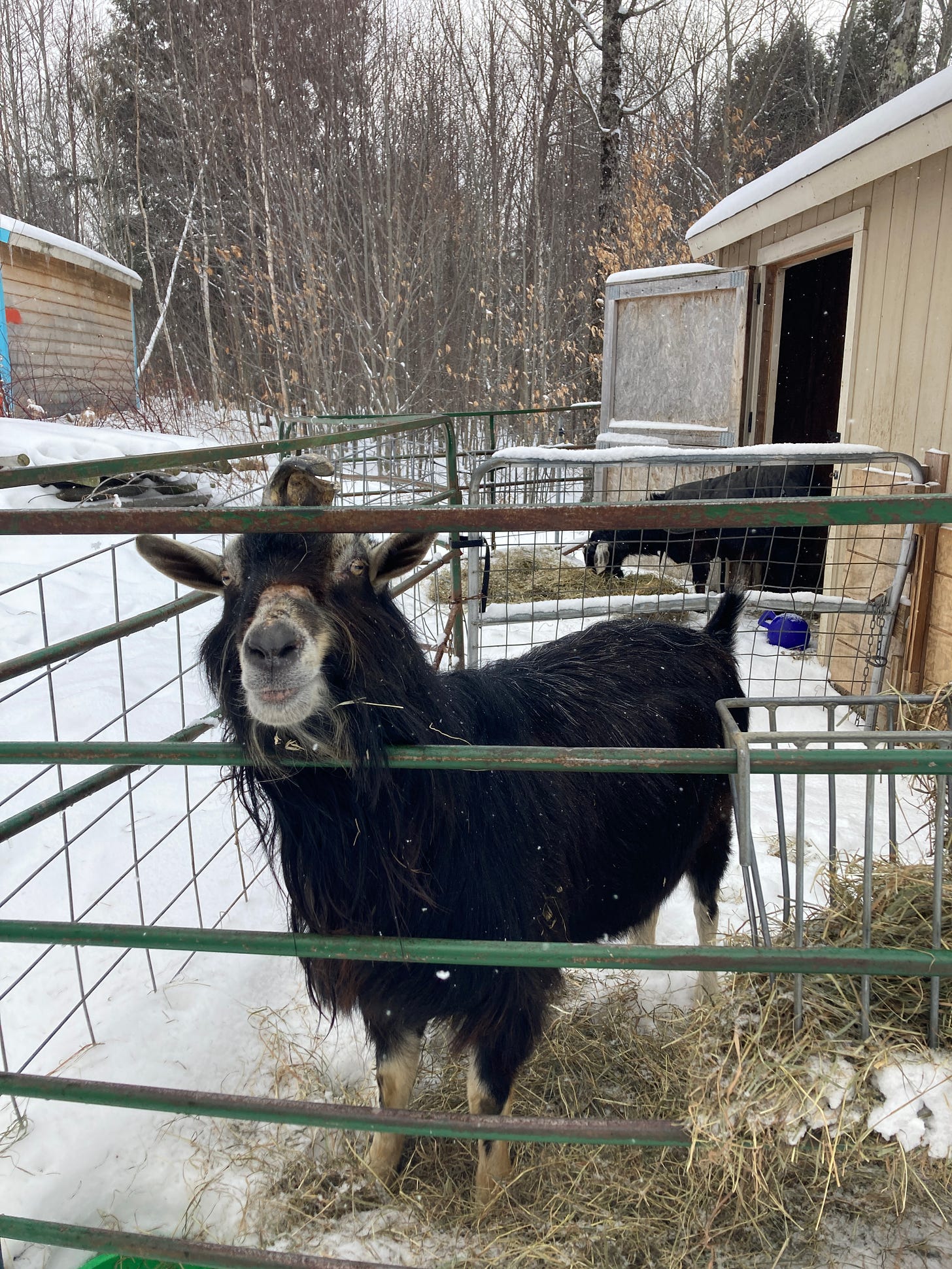
When I first looked at Puku, I thought "a calico goat!" Then you described her and I knew it was true, because torties and calicos have TORTITUDE, where they are the boss and don't you forget it. I had a tortie for 20 years so I'm delighted.
I'm glad Weird Barbie Goat has a loving home, and I have now said "goat coat" so many times it's lost all meaning.
What a heartwarming and informative tale.
Your deeply felt love and determination shines throughout this story.
Our broken humanity desperately needs many more heroines such as you.
My sincerest thanks to you.
Liam, an Irish vegan.